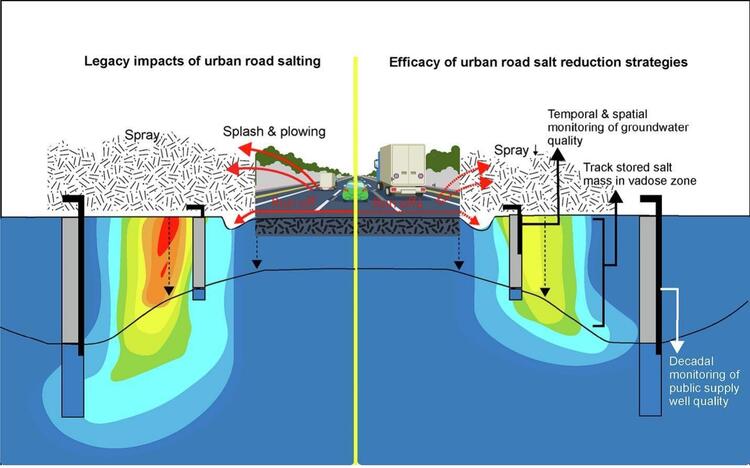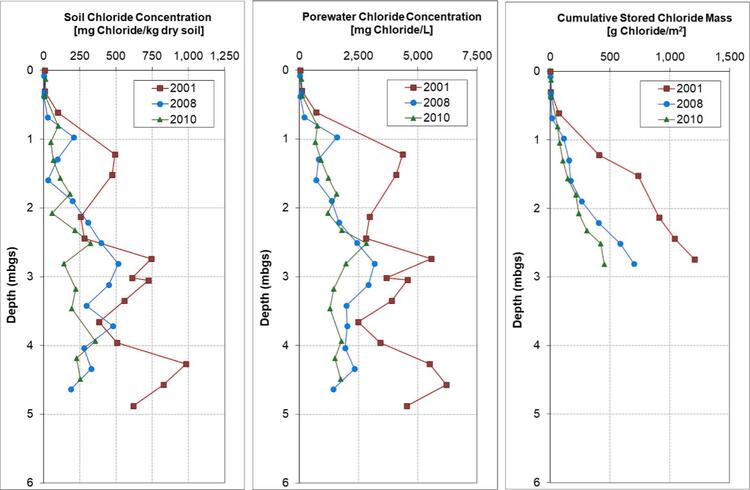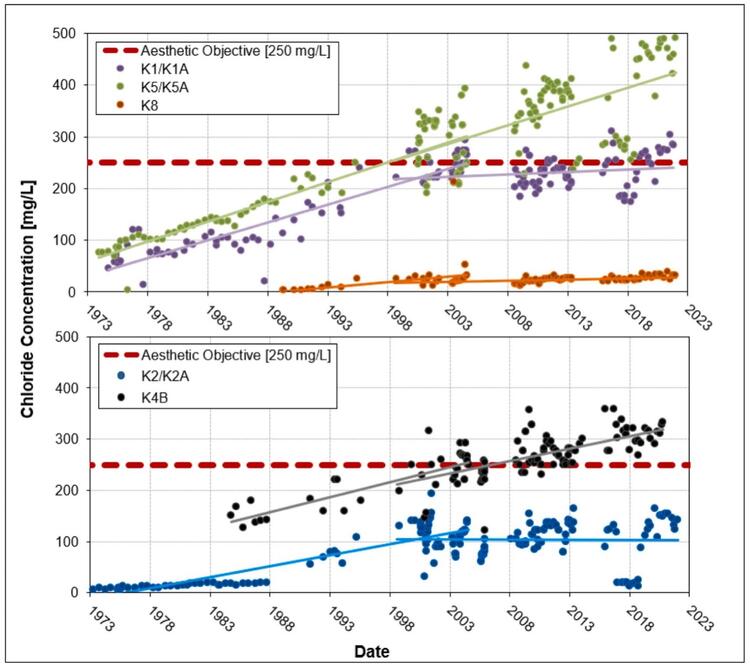Contact
Dave Rudolph
Department of Earth and Environmental Sciences
Introduction
Road salt is the most common deicing agent used for winter road maintenance. Where groundwater is the source of drinking water, deicers can result in the chronic degradation of water quality within supply wells. A variety of Best Management Practices (BMPs) have been implemented to mitigate the adverse environmental impacts of road salt, but few studies have quantified BMP efficacy due to the complexity of developing quantitative metrics to gauge their performance and the inherently long-time frames required to observe measurable changes in the subsurface.
The objective of the study was to quantify the effects of road salt reduction strategies on groundwater resources within a large municipal well field located in the Region of Waterloo, Ontario, Canada that has experienced progressively increasing levels of chloride. This may be the first study of its kind to report both the short-term response to BMP implementation in soil pore water and shallow groundwater and the time-lagged response of deep public supply wells. Results of this long-term study aim to provide unique insight into the fate and transport of groundwater chloride originating from seasonally applied road salt and the efficacy of road salt reduction strategies.
Methodology
The Region of Waterloo relies on groundwater from a network of over 120 wells that provide 75% of its potable water supply. Within this network, the Greenbrook well field consists of five wells that cumulatively produce ~7.3 million L/day from overburden aquifers at an average depth of ~30 m below ground surface. Chloride concentrations in the Greenbrook wells have progressively increased over time sometimes exceeding the aesthetic drinking water objective of ≤250 mg/L. During the winter of 2003-04, the Region of Waterloo and City of Kitchener implemented several salt reduction BMPs aimed at reducing road salt application rates by 25% within the 10-year capture zone of the well field.
The study identified seven representative monitoring sites within Greenbrook capture zone where shallow groundwater monitoring wells were installed. Temporal changes in groundwater chloride concentrations between 2002 and 2021 were used to compare pre- and post-BMP chloride levels. The particle size distribution, volumetric water content, soil chloride concentrations and pore water chloride concentrations were also determined on sediment samples from each monitoring site during pre- and post-BMP sampling periods.
The Region of Waterloo has routinely monitored water quality in the Greenbrook supply wells since the early 1970's. The study examined temporal changes in pre- and post-BMP chloride levels in the supply wells from 1973 to 2022 to quantify the impact of the road salt reduction BMPs. Figure 1 depicts objectives of the monitoring program.

Figure 1: Schematic showing monitoring program objectives.
Outcomes
Chloride concentrations and mass in the sediment samples were highly variable with depth and time both at and between the monitoring locations. The peak soil concentrations at most sites were interpreted to reflect the annual salt loading events during the spring melt period. Depending on the annual recharge rate at a given site, these data suggest that two or more years of annual salt loadings may be stored within the 3 to 4 m thick vadose zone above the water table (Figure 2).

Figure 2. Profiles of soil and pore water chloride concentration through the entire cored region and cumulative stored Cl− mass within the vadose zone (2001, 2008, & 2010) at the GB1-01: Belmont Ave. site.
Following implementation of the BMPs, pore water chloride concentrations measured in the vadose zone decreased at six monitoring sites and increased at one site close to an elementary school where an increased frequency of salt application was likely. When considering the combined data, the average chloride concentrations above the water table decreased from approximately 3000 mg/L to <1000 mg/L following implementation of the road salt reductions which corresponds to a 60% reduction in stored chloride mass. The post-BMP cumulative stored chloride mass above the water table decreased at five sites and increased two sites. Overall, a reduction of stored chloride mass of approximately 40% was observed after the BMPs were initiated.
Prior to the implementation of the BMPs, groundwater chloride concentrations were highly variable between monitoring stations and during the year. Following implementation, concentrations began to gradually decrease at three sites where they were initially the highest. At the other three sites, levels increased slightly over time. The nature of the road salt application and resulting variable annual total salt loads are related to seasonal and annual changes in temperature and precipitation that influence winter road conditions. Overall, the average shallow groundwater chloride concentration decreased from ~1100 mg/L in 2001 to ~700 mg/L in 2022 representing an ~35% reduction in chloride concentration at the shallow water table (Figure 3).

Figure 3. Chloride concentrations in groundwater monitoring wells at the field monitoring sites from the time of their initial installation in 2001 and 2022. The road salt reduction BMPs were implemented 2003.
During the study period, increasing trends in chloride concentration were observed in each of Greenbrook supply wells. While the production wells are situated relatively close to each other their concentrations were are very different due to the complex nature and interaction between the pumping of individual supply wells, annual salt application patterns and loads and the regional groundwater quality. To assess the influence of the BMPs on the water quality of supply wells, linear trend lines were plotted for each well for pre-BMP and post-BMP periods. All supply wells except one showed an overall decrease in the slope of the trend lines following the implementation of the BMPs, while chloride levels in four of the five wells remained close to or below the aesthetic objective of 250 mg/L (Figure 4).

Figure 4. Historical chloride concentrations in the raw water of the Greenbrook Well Field production wells (1973–2023). The road salt reduction BMPs were implemented in the fall of 2003.
Conclusions
The study investigated an urban municipal well field showing progressive increases in groundwater chloride levels to assess the effectiveness of road salt reductions BMPs. The integration of data sets from different spatial and temporal scales collected at several monitoring locations provided unique insight into the long-term impact of road salts on groundwater quality and the effectiveness of a BMP strategy to reduce their impact on a public groundwater supply.
Vadose zone data provided early evidence that the BMPs resulted in a decrease in pore water chloride concentration and stored salt mass along the majority of the road curbside environments. Groundwater chloride concentrations measured in shallow monitoring wells varied significantly from site to site, indicating a high degree of spatial variability in road salt mass loading within the urban road network. Notably, the shallow groundwater data provided early evidence to suggest a progressive decrease in salt loading following the salt reduction BMP activities.
Slow increasing trends in chloride concentration were evident in each supply well prior to the BMP implementation, with slow but consistent reductions in these trends observed at four of five wells after road salt application rates were reduced. Supply well chloride concentration histories, however, were very different indicating that the wells were capturing salt mass from different sources depending on their individual capture zone geometries and operational histories.
The study recommends that BMP effectiveness continue to be assessed through monitoring of the shallow subsurface and the public supply wells to document the ongoing influence of road salt reduction BMP strategies. While the focus of the study was on groundwater, it was also recommended that future work assess the impact of the road salt reduction BMPs on surface water quality.
Read more in Science of The Total Environment
Rudolph, D.L., Melchin, J., Stone, M., Sarwar, G., Hodgins, E. Efficacy of urban road salt reduction strategies on public supply well quality. Science of The Total Environment. November, 2023. https://doi.org/10.1016/j.scitotenv.2023.166466
For more information about WaterResearch, contact Julie Grant.








